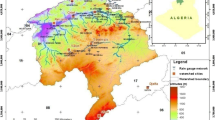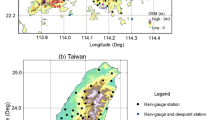Abstract
The objective of this study is to suggest a methodology for estimating the time-variant probable maximum precipitation. First, the greatest amount of precipitation for a relatively long duration, e.g., a month or longer, defined as the Long-term Probable Maximum Precipitation (LPMP) in the present work was estimated. Then, the procedure for using the LPMP estimates for determining the temporally varied upper limit of precipitation during a certain period of the year, defined as the time-variant PMP (TPMP) in this study was implemented. Hershfield's statistical approach was used to estimate LPMP, i.e., monthly, calendar monthly, and cumulative monthly, for each of 61 weather stations located in South Korea, and nationwide distribution maps of three types of LPMP were made. In particular, using the cumulative monthly PMP estimates and total antecedent precipitation prior to a certain time, the TPMP for a certain duration was forecast for example problems. From the case study for precipitation data at Chungju weather station, TPMP forecasts at certain stormy periods were substantially smaller than the design PMP, which implies that reservoir operation for flood control based on the design PMP may be too restrictive for some period. It is expected that the TPMP can serve as a complementary index to increase the water supply of a reservoir.
Similar content being viewed by others
References
Bruce, J. P. and Clark, R. H. (1966). Introduction to hydro-meteorology, New York, Pergamon.
Chow, V. T. (1951). “A general formula for hydrologic frequency analysis.” Transactions American Geophysical Union, Vol. 32, No. 2, pp. 231–237, DOI: 10.1029/TR032i002p00231.
Collier, C. G. and Hardaker, P. J. (1996). “Estimating probable maximum precipitation using a storm model approach.” Journal of Hydrology, Vol. 183, No. 3, pp. 277–306, DOI: 10.1002/joc.2149.
Desa, M. N. and Rakhecha, P. R. (2007). “Probable maximum precipitation for 24-h duration over an equatorial region: Part 2-Johor, Malaysia.” Atmospheric Research, Vol. 84, No. 1, pp. 84–90, DOI: 10.1016/j.atmosres.2006.06.005.
Desa, M. N., Noriah, A. B., and Rakhecha, P. R. (2001). “Probable maximum precipitation for 24-hr duration over Southeast Asian monsoon region-Selangor, Malaysia.” Atmospheric Research, Vol. 58, No. 1, pp. 41–54, DOI: 10.1016/S0169-8095(01)00070-9.
Desa, M. N., Sharifuddin, M. N., and Rakhecha, P. R. (2003). “To estimate 24-hour probable maximum precipitation for the Malaysian state of Kelantan.” International Water Power and Dam Construction, pp. 35–39 (November issue).
Dhar, O. N. and Kamte, P. P. (1969). “A pilot study of the estimation of the probable maximum precipitation using Hershfield Technique.” Indian Journal of Meteorology and Geophysics, Vol. 22, No. 1, pp. 31–34.
Dhar, O. N., Kulkarni, A. K., and Sangam, R. B. (1975). “Study of extreme point rainfall over flash flood prone regions of the Himalayan foothills of North India.” Hydrological Sciences Bulletin, Vol. 20, No. 1, pp. 61–67.
Douglas, E. M. and Barros, A. P. (2003). “Probable maximum precipitation estimation using multifractals: Application in the eastern United States.” Journal of Hydrometeorology, Vol. 4, No. 6, pp. 1012–1024, DOI: 10.1175/1525-7541(2003)004<1012:PMPEUM>2.0.CO;2.
Eliasson, J. (1997). “A statistical model for extreme precipitation.” Water Resources Research, Vol. 33, No. 3, pp. 449–455, DOI: 10.1029/96WR03531.
Hansen, E. M., Schreiner, L. C., and Miller, J. F. (1982). Application of probable maximum precipitation estimates-United States East of the 105th meridian, Hydrometerological Report No.52, National Weather Service.
Hansen, E. M., Schwarz, F. K., and Riedel, J. T. (1977). Probable maximum precipitation estimates, Colorado river and great basin drainages, Hydrometeorological Report No.49.
Hart, T. L. (1981). “Survey of probable maximum precipitation studies using the synoptic method of storm transposition and maximization.” Proceedings of the Workshop on Spillway Design, Australian Government Publishing Service, Monash University, Melbourne, pp. 53–63.
Hershfield, D. M. (1961). “Estimating the probable maximum precipitation.” Journal of Hydraulics Division, ASCE, Vol. 87, No. 9, pp. 99–106.
Hershfield, D. M. (1965). “Method for estimating the probable maximum precipitation.” Journal American Water Works Association, Vol. 57, No. 8, pp. 965–972.
Koutsoyiannis, D. (1999). “Probabilistic view of Hershfield's method for estimating probable maximum precipitation.” Water Resources Research, Vol. 35, No. 4, pp. 1313–1322, DOI: 10.1029/1999WR900002.
Ministry of Construction and Transportation, MOCT (2000). Study on the water resources management technique: II. Estimation of probable maximum precipitation in Korea, KICT.
Ministry of Construction and Transportation, MOCT (2004). Restimulation of probable maximum precipitation in Korea, KICT.
Myers, V. A. (1967). “The estimation of extreme precipitation as the basis of design floods-resume of practice in the United States.” Symposium at Leningrad, International Association of Scientific Hydrology, Gentbrugge, Belgium, Publication, Vol. 84, pp. 84–101.
Paulhus, J. L. H. and Gilman, C. S. (1953). “Evaluation of probable maximum precipitation.” Trans. A.G.U., Vol. 34, No. 5, pp. 701–708, DOI: 10.1029/TR034i005p00701.
Rakhecha, P. R. and Soman, M. K. (1994). “Estimation of probable maximum precipitation for a 2-day duration: Part 2-North Indian Region.” Theoretical and Applied Climatology, Vol. 49, No. 2, pp. 77–84, DOI: 10.1007/BF00868192.
Rakhecha, P. R., Deshpande, N. R., and Soman, M. K. (1992). “Probable maximum precipitation for a 2-day duration over the Indian Peninsula.” Theoretical and Applied Climatology, Vol. 45, No. 4, pp. 277–283, DOI: 10.1007/BF00865518.
Weather Bureau (1938). A hydrometeorological analysis of probable maximum precipitation over St. Francis river basin, Hydrometeorological Report No.8.
Wiesner, C. J. (1970). Hydrometerology, Chapman and Hall Ltd., London.
World Meteorological Organization (1986). Manual for estimation of probable maximum precipitation, Second Edition, Operational Hydrology Report No.1, WMO No. 332.
Author information
Authors and Affiliations
Corresponding author
Rights and permissions
About this article
Cite this article
Kim, N.W., Lee, J. Estimation of time-variant probable maximum precipitation for South Korea. KSCE J Civ Eng 21, 1031–1038 (2017). https://doi.org/10.1007/s12205-016-1052-x
Received:
Accepted:
Published:
Issue Date:
DOI: https://doi.org/10.1007/s12205-016-1052-x




